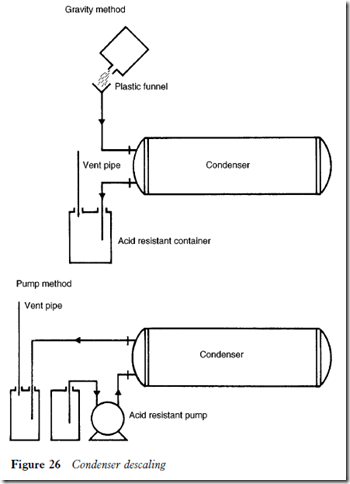Water cooled condensers: scale and corrosion
Scaling
Any type of water cooled condenser is prone to scaling of the interior surfaces of the water tubing. The rate at which the scale forms will depend upon the condensing temperature and the quality of the water circulated. Scaling will be relatively low where condensing temperatures are below 38 °C.
Shell and tube condensers are fitted with removable end plates to enable cleaning to take place by means of a wire brush. This is satisfactory for mild scale build-up, but heavy scale deposits may necessitate removal by chem- ical means.
Scale can be removed with descaling agents, which are available in both liquid and powder forms. Solutions of chemicals and water can be used as follows:
1 Muriatic acid 18 per cent and water 82 per cent for rapid descaling.
2 Hydrochloric acid 22 per cent and water 78 per cent for slower but equally effective action.
Descaling processes can be carried out by a gravity flow method or by means of a pump. However, it must be realized that all descaling agents are acid based; therefore any pump must be acid resistant. Never use a system recirculating pump for this purpose. Figure 26 shows layouts for the two methods.
Descaling solutions can damage flooring, paintwork, clothing and plant life. They are obviously a health hazard, and contact with eyes and skin must be avoided. Adequate protective clothing must be worn, and precautions against spillage must always be taken.
When cleaning condenser coils or tubes the working areas must be well ventilated. A vent pipe is a vital part of the cleaning equipment; it will carry off the toxic fumes which are generated by the chemicals during the cleaning process.
Corrosion and contamination
In addition to scaling, water cooling systems are subject to corrosion from fumes given off by nearby industrial plant. Concentrations of sulphur and salts will be present in the atmosphere.
Systems installed in a coastal area are susceptible to corrosion by salt borne by the air.
There will always be the problem of algae growth and bacterial slime. These can only be controlled by regular cleaning and the use of various algaecides. Inhibitors such as Hydrofene have been used over a long period without any ill effect being observed.
